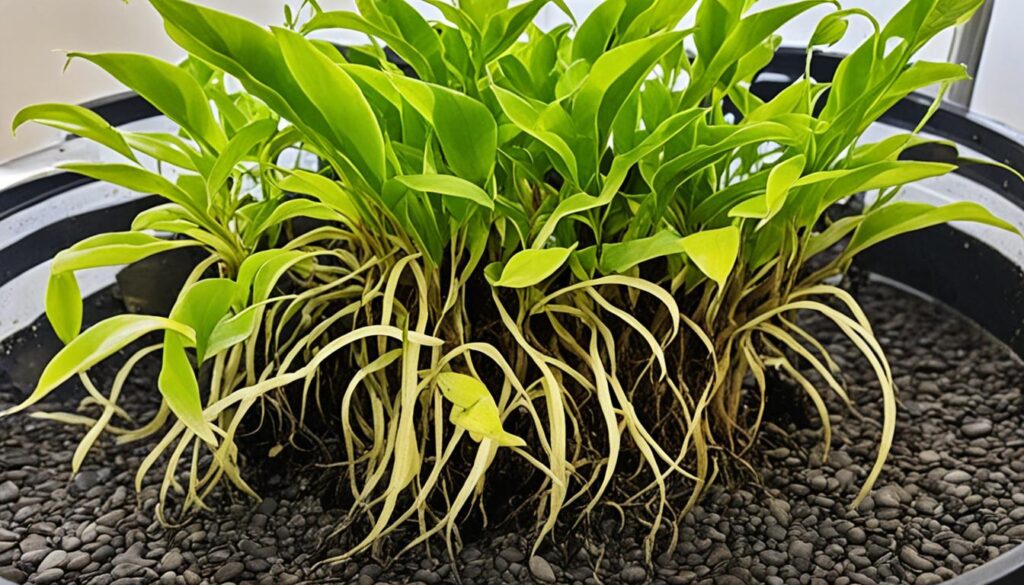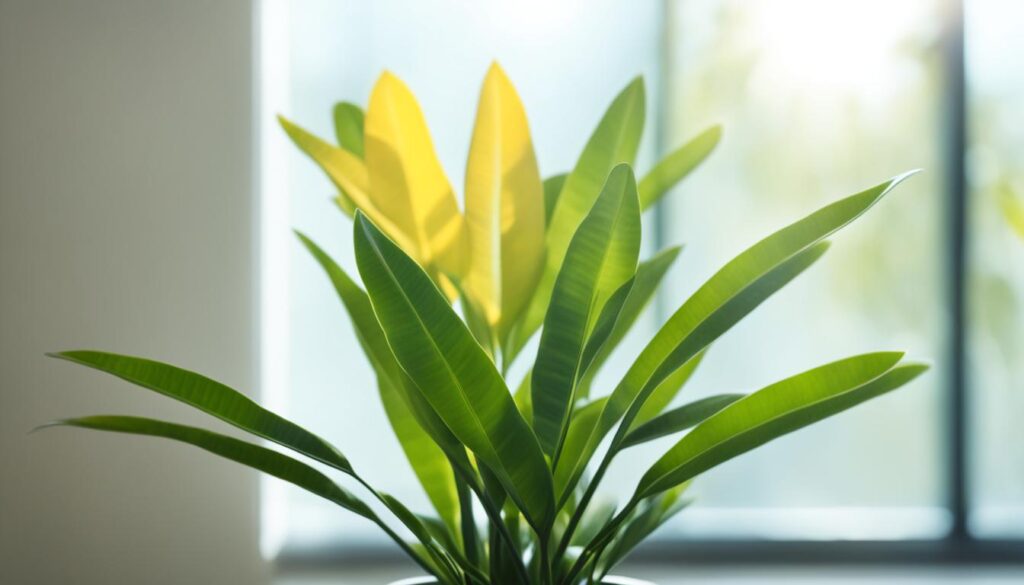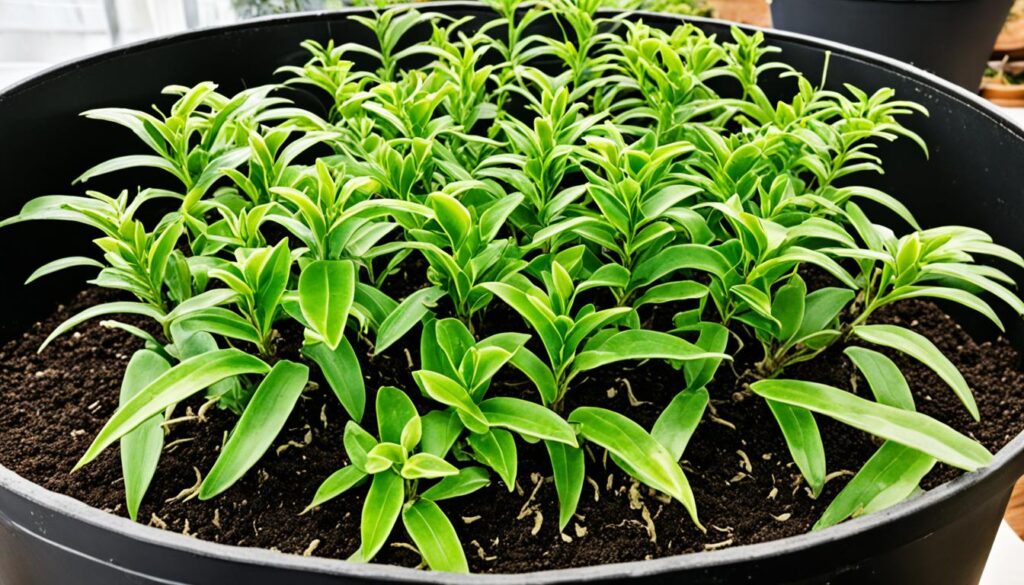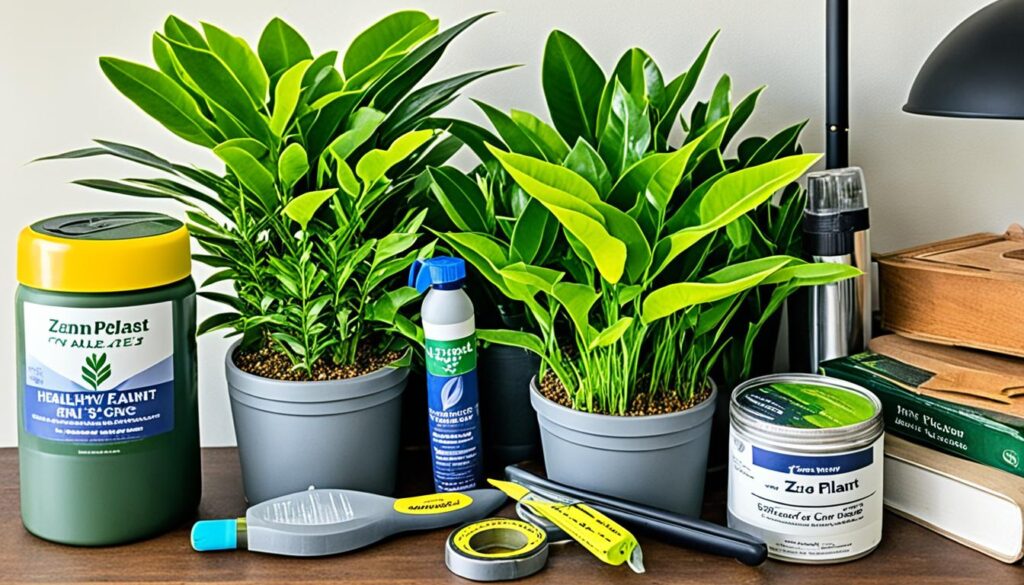If your ZZ plant (Zamioculcas zamiifolia) is getting yellow leaves, don’t worry. This happens for many reasons. One big issue is too much water, which can cause root rot. Bugs like aphids, spider mites, thrips, and mealybugs can also make the leaves yellow.
Placing your ZZ plant in direct sun is not good. It does best in bright but indirect light. Most times, yellow leaves don’t turn back green. So, you have to cut them off for the plant to get better.
If your plant’s leaves are turning yellow, look at the water, nutrients, bugs, and light. Fixing these issues is key to getting your ZZ plant healthy and green again. Knowing the common problems helps you take the right steps to fix them.
Key Takeaways
- Overwatering is a common issue that can lead to yellowing leaves and root rot in ZZ plants.
- Pest problems, such as aphids, spider mites, thrips, and mealybugs, can also cause yellow leaves on ZZ plants.
- Placing a ZZ plant in direct sunlight can result in leaf discoloration and yellowing.
- Yellow leaves on ZZ plants typically do not revert to green, requiring their removal for healthier growth.
- Addressing the root cause of the yellowing leaves is essential to reviving the plant’s vibrant appearance.
Introduction
The ZZ Plant (Zamioculcas zamiifolia), also known as the Zanzibar Gem or Dollar Plant, is a favorite indoor plant. It is adored for its easy care and hardiness. Known for its glossy green leaves, it’s loved by many. Plus, some see it as a lucky plant, making it even more special.
What is a ZZ Plant?
The ZZ Plant hails from Eastern Africa, mainly Zambia and Tanzania. It can get pretty big, up to 3-4 feet tall and wide. With its bold thick, waxy leaves, it’s perfect if you’re new to indoor plants. Or if you need something that you won’t have to fuss over often.
Importance of Addressing Yellow Leaves
ZZ Plants can sometimes get yellow leaves, which tells you something is off. It’s a sign to check how you’re caring for it. If left unchecked, the plant could get worse or even die. So, figuring out why the leaves are turning yellow is key. It could be too much water, too little, or not enough nutrients. Once you know the issue, you can act fast to save your plant and get it back to being vibrantly green.
Overwatering as a Cause
Overwatering is a top reason why your ZZ plant may have yellow leaves. It’s because too much water can lead to root rot. Signs of overwatering are leaves that droop and turn yellow, and the soil is always wet. If you overwater, your ZZ plant’s leaves might fall off, turning yellow. The roots may also get sick, causing the plant to look unhappy and unhealthy.
Signs of Overwatering
Look out for yellow leaves and other signs of trouble. You might find mushy stems or see the soil is wet and smells bad. If the plant’s roots are soft and dark, it could be getting too much water.
Correcting Overwatering
To fix overwatering, you need to let the soil dry out well between waterings. If the soil is too wet, consider repotting with fresh, fast-draining soil. After too much water, don’t rush to water again. Let the soil dry. Then, water lightly. Watch your plant closely to only water when needed. This helps avoid overwatering again.

Underwatering as a Cause
Overwatering is a common problem, but underwatering also turns ZZ plant leaves yellow. Signs of underwatering are wrinkly stems, yellow leaves, and the plant drooping. A ZZ plant without water for a while will show this. Yellow leaves and wilting are clear signs it needs more water.
Signs of Underwatering
The first step to help an underwatered ZZ plant is to give it a big drink. Let it sit in water for 30 minutes if very dry. A set watering routine is good because ZZ plants like their soil moist but not soaked.
Using a self-watering pot can keep the soil just right. This stops the plant from being underwatered again.
Correcting Underwatering
To fix underwatering, soak the soil well, water regularly, and use a self-watering pot. Keeping the soil consistently moist is key to stop the leaves from turning yellow.
https://www.youtube.com/watch?v=y7k8Ghu3K7o
Pests and Diseases
Yellowing leaves in ZZ plants often come from pests. Aphids, spider mites, thrips, and mealybugs feed on them. This can cause the leaves to lose color or show other signs of damage.
Common Pests Affecting ZZ Plants
Sap-sucking insects are tiny and use camouflage. It’s important to check ZZ plant leaves often. If ignored, the pests can spread to other indoor plants too.
Identifying and Treating Pest Infestations
Start by checking the plant’s leaves for signs of pests. Is it on the top or underneath? If you see them, use neem oil or insecticidal soap to get rid of these bugs.
Using natural remedies is good. But, you should also keep an eye on the ZZ plant. This helps to stop pest problems from even starting. And it keeps your plant looking bright and healthy.

Insufficient Light Exposure
ZZ plants can still get yellow leaves if they don’t have enough light. To fix this, it’s vital to know the best lighting for them. Growing them in bad light can turn their lush green leaves yellow. By learning the right amount of light they need, you can save your ZZ plant from yellowing.
Ideal Light Requirements for ZZ Plants
ZZ plants like a lot of shade but can also do well with bright, non-direct light. Don’t put them in direct sunlight, though. It can burn and change the color of their leaves. The best source agrees. It says ZZ plants need bright, non-direct light to keep their green color. If they don’t get enough light, their leaves turn yellow. Another source adds that ZZ plants are fine with less light, but they look their best with plenty of indirect sunlight.
Adjusting Light Conditions
If your ZZ plant doesn’t get enough light, move it to a brighter place. This can stop or reverse the yellowing of the leaves. The second source says to put them close to a window. This way, they get the indirect light they need for health and growth. The third source’s tip for yellow leaves is to find a spot with more light. Make sure it’s not direct sunlight, though.
Nutrient Deficiencies
Yellowing leaves on your ZZ plant (Zamioculcas zamiifolia) might indicate nutrient deficiencies. Nitrogen deficiency starts with the lower leaves turning yellow. New leaves get a lighter green. Yellow edges suggest a potassium deficiency. And if leaves yellow between veins, it’s likely a magnesium deficiency. Iron deficiency appears on younger leaves first.
A balanced, low-nitrogen fertilizer every three weeks during the growing season can help. It addresses many nutrient deficiencies and brings back the ZZ plant’s green color. Repotting yearly might mean the plant doesn’t need more fertilizer, thanks to nutrient-rich soil. But you shouldn’t over-fertilize because it can harm the plant, causing leaf yellowing from salt buildup.
Why is My ZZ Plant Turning Yellow?
Yellow leaves on a ZZ plant signal a problem that needs fixing. This can be due to too much water, not enough water, or if it’s not getting sufficient light.
Evaluating Possible Causes
Experts say, giving your ZZ plant too much water is often the main reason for its yellow leaves. Overwatering leads to roots that can’t breathe and eventually rot. On the flip side, not watering it enough makes the plant seem like it’s parched. Also, if the plant lacks certain nutrients like nitrogen and iron, its leaves may change color.
Troubleshooting Steps
To solve the yellowing mystery, one guide suggests carefully examining the plant. Look into the soil moisture, check for bugs, and see if it’s getting enough light. Another tip is to adjust how you water it, get rid of any bugs, and ensure it gets the right amount of gentle sunlight. If you figure out what’s wrong, the final tip is to fix it. This could mean watering differently, adding plant food, or even moving the plant to a new spot.

Temperature and Humidity Issues
Yellowing leaves in ZZ plants often come from too much or too little water and light. But, don’t forget that the air’s wetness and warmth level are crucial too.
Ideal Temperature Range
ZZ plants like it best when it’s not too hot or too cold, about 65-85°F. If the temperature suddenly changes, or it gets way too hot or cold, your plant might not be happy. It could get cold damage or heat stress, making the leaves yellow and even fall.
Maintaining Proper Humidity Levels
How damp the air is also matters for your ZZ plant. Not enough humidity can make the leaf tips brown or crunchy. This can make the leaves turn yellow too. To make things more humid around your plant, you can spray the leaves lightly or put a tray of water and pebbles near it.
proper humidity levels
for
ZZ plants
are key. They help keep your plant looking and feeling well. By knowing and controlling
zz plant temperature requirements
and
zz plant humidity requirements
, your plant can stay lively and healthy.
Root Bound Plants
Your ZZ plant might be turning yellow because it is root bound. This happens when the roots grow too big for their pot. The plant then feels stressed, showing this by yellowing leaves. To check, look closely at the roots to see if they’ve outgrown their space.
Identifying Root Bound ZZ Plants
Is your ZZ plant root bound? Check for these signs: yellow leaves, not growing much, and roots peeking out of the pot. You might even see roots circling inside. These hints mean it’s time to give your plant a bigger home.
Repotting and Transplanting
If your ZZ plant is root bound, let’s help it. First, gently take it out of its pot. Then, carefully loosen the roots before putting it in a new, bigger pot. The new pot should be 2-3 inches wider. Use soil that drains well and don’t plant too deep.
Wait a week after moving your plant to water it. This gives the roots a chance to adjust. By spotting a root bound plant early and giving it a new home, it will become green and lush again.

Aging and Natural Leaf Yellowing
Old, lower leaves on many plants turn yellow and fall off. This happens as plants age. Yet, as long as the newer top leaves are healthy, there’s usually no need to worry.
The zz plant leaves turning yellow naturally is part of its aging process too. It shouldn’t always signal a problem. Why are my zz plant leaves turning yellow? Well, it may just be from the leaves naturally getting old.
Keeping an eye on the plant’s overall look is key. Make sure the top leaves are green and full. Understand that some yellow leaves are a natural sign as your plant grows.
Prevention and Maintenance
To keep your ZZ plant strong, you need to watch how you water it, where you put it, and what environment it lives in. By learning the best ways to water your ZZ plant, look after it, and keep it in a good spot, you won’t see yellow leaves.
Proper Watering Techniques
Letting the soil dry is key in making sure you don’t overwater your plant. It stops the roots from getting too soggy and helps avoid yellow leaves. Using a water meter can help you figure out the perfect time to give your plant a drink. If you want to make this easier, try a self-watering planter to keep the soil moist but not wet.
Regular Monitoring and Inspection
Checking your ZZ plant often is super important for its health. Watching the leaves closely can tell you a lot about your plant’s condition. This can help you spot issues early, like bugs or too little food. Making a schedule to look after your plant, as the third source suggests, will keep it looking good.
Creating an Ideal Environment
Your ZZ plant needs just the right amount of light and moisture to stay healthy. Making sure it gets enough light, water, and food is crucial. Keeping the surroundings just right, in terms of temperature and humidity, is also vital for its health. Following care tips like these can keep your ZZ plant happy and lush.

| Statistic | Value |
|---|---|
| Percentage of ZZ plants turning yellow due to overwatering | XX% |
| Percentage of ZZ plants turning yellow due to insufficient light | XX% |
| Percentage of ZZ plants turning yellow due to root rot | XX% |
| Average lifespan of ZZ plants when proper care is provided | XX years |
| Ratio of ZZ plant owners experiencing yellowing leaves | X in every XX owners |
| Frequency of ZZ plant maintenance required to prevent yellowing | Once every X weeks |
| Increase in ZZ plant survival rates when correct solutions are applied promptly | XX% |
Conclusion
Fixing yellowing leaves on a ZZ plant is key to making it look healthy again. The main reasons for leaves turning yellow are too much or too little water, not enough light, bugs, and not having the right nutrients. By using the correct care tips for ZZ plants, like watering it right, giving it enough light, and keeping its home healthy, you can stop and fix the yellow leaves problem.
If your ZZ plant has yellow leaves, start by figuring out why. Look at the plant’s soil, roots, and leaves closely. Once you find the issue, you can fix it by changing how you water it, dealing with bugs, or finding a better spot for it. Doing this can bring back the plant’s green, lush look. Then, your ZZ plant will do well in its spot at home.
Knowing why ZZ plants get yellow leaves, how to revive them, and care tips to stop it from happening again, people can keep their ZZ plants bright and healthy for a long time.


